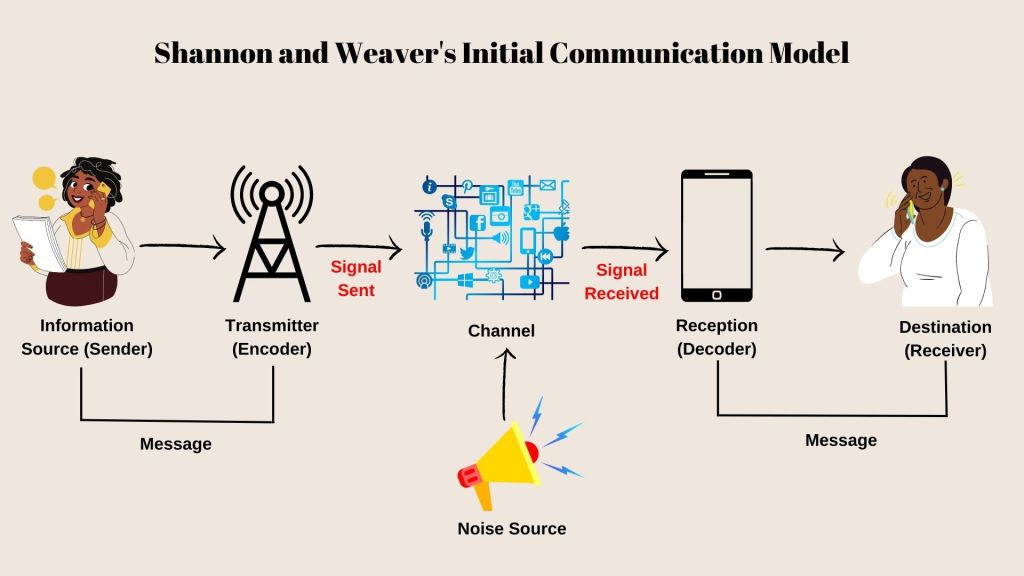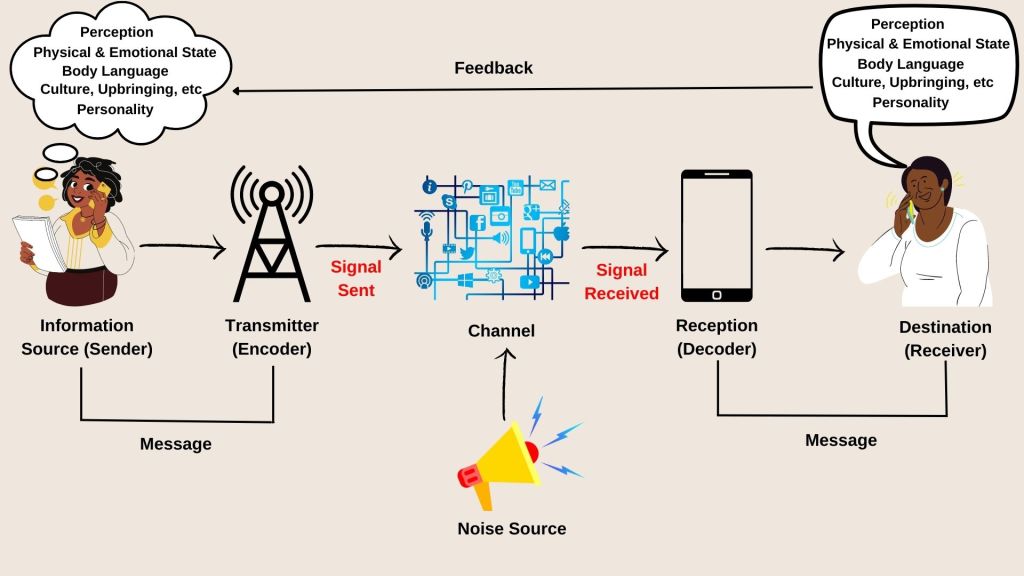What is it?
Shannon and Weaver’s Communication Model, also known as the Information Theory model, was created in 1948 by Claude Shannon and Warren Weaver. Their goal was to identify and understand the points where communication can be jumbled up or misconstrued during the sending and receiving process. While the concept was revolutionary at the time, it is widely understood that it has limits and is not a perfect portrayal of the complexity of communication.
How it works?

The initial Shannon And Weaver’s communication model was focused on information transmission, from a sender to a receiver, viewing communication as a linear process. It is made up of five essential components: information source (sender), transmitter (encoder), channel, reception (decoder), and destination (receiver). Noise is a factor that influences communication, as illustrated in the model. Noise can be internal or external. Internal noise can be interpreted as a mistake by the sender (misspelling of words) or by the receiver (misinterpretation of sender’s message). External noise can be interpreted as external factors that affect the communication such as a busy road, weak signal etc.
Example:
Bob uses WhatsApp to call his friend Jill. Bob is the information source (sender). His phone is the transmitter (encoder). The channel is WhatsApp. Jill’s phone is the reception (decoder). Jill then is the destination (receiver). However, based on the model, noise could also occur due to the activities going on surrounding them or due to weak signal, causing Jill not to hear Bob clearly.
Is the initial communication model complete?
Shannon And Weaver’s initial model oversimplified communication and ignored important factors that are crucial to communication. It focused solely on the technical aspects of communication such as encoding, transmission and decoding of messages without considering the complexity of human interactions and communication.
The model presupposed a one-way flow of information, a linear one, from sender to receiver, ignoring the interactive and ever-changing nature of natural communication between people. It also failed to acknowledge the importance of feedback in communication. An example of a linear one-way communication is a person watching the news on television. He is only receiving one-way information from the newscaster and is not able to provide his own feedback to the newscaster regarding the news he just heard.

Furthermore, the model ignored the impact of cultural, social and language context on communication. Based on the initial model, it implied that everyone understands and comprehends each other’s messages without taking into account their culture, language or upbringing which may alter their perception of the message that the sender is trying to imply. For example, in the standard Malay language, the word “Bayi” means baby but in Bruneian Malay, the same word means “Pig”. The first time I went to Brunei, I wanted to buy shirts for my baby cousin so I asked the staff for “Baju Bayi” but the staff looked at me funny. Only when his manager explained to me that “Bayi” in Bruneian Malay means “Pig” then I understood why.
Perception of the sender/receiver regarding the conversation and their physical & emotional state was also one of the factors overlooked by the initial model. People feedback differently to the conversation/communication depending on how they pre-perceived it to be inside their minds and also depending on how they feel. For example, a student, who was tired from staying up all night doing assignments, has to attend a 3 hour long lecture that he already perceives to be very dry and boring, at 8am in the morning. He will thus feel unmotivated and will not engage with any of the lecturer’s prompts or questions, hence making the lecture a one-way communication.
Non-verbal cues like body language, facial expressions, hand gestures and tone of voice in face-to-face communications was also not considered in the initial communication model. Non-verbal cues are important factors to consider in communication. For example, if you are not interested in talking to somebody, you will not want to face that person and you will try to look nonchalant so you can make your escape as soon as possible. You will also not be listening to what they are saying, making the communication disrupted. Therefore, based on these shortcomings, we can conclude that Shannon And Weaver’s Initial Communication Model is incomplete.
How will I modify it?

I would modify and adapt some new concepts to the initial communication model by including feedback from the receiver to the sender, taking into account the context of the conversation for example cultural, social and language context. Perception of the receiver/sender regarding the conversation and their physical & emotional states are also important.
If the communication is face-to-face, the body language of both the receiver/sender plays a part also, hence I included it in. Based on my suggested model, this will enable a two-way feedback, taking into account human factors to keep communication going and information exchanged despite the presence of any noise (internal or external).


5 responses to “Shannon And Weaver’s Communication Model”
Hi Irfan! I agree that the Shannon and Weaver’s Model of Communication is incomplete. As mentioned in your analysis above, the model does not consider the various cultures that people around the world have. A friendly interaction in one culture may feel like unnecessary intrusion on their personal space in another one. By learning about other cultures in advance, one can then avoid appearing as ignorant or rude. A somewhat related incident I recall is that there are people I met who gave me a slap on the back as a friendly greeting, but to me it felt like an act of trying to show aggression. This shows me how the same action can be perceived differently even in a simple greeting.
LikeLiked by 1 person
Hey Irfan! I completely agree with you that the Shannon and Weaver’s model is incomplete. The way you talked about the social and cultural aspect was perfect, I couldn’t agree more as I have my fair share of communication problems with friends from overseas. I didn’t factor in physical gestures and I thought that was very creative of you and opened my eye to another form of communication as I was too focused on online communication. I too agree that adding feedback as it would offer a two-way communication instead of a one way from the incomplete Shannon and Weaver model.
LikeLiked by 1 person
Hello Irfan! To begin, I want to say how much I loved reading your blog post. You shared your own personal experiences, which many of us are able to connect with on some level. Your example demonstrates how communication can suffer greatly from language barriers and cultural differences. It shows that even seemingly simple phrases can hold different meanings depending on the context in which they are used, which can lead to misunderstandings and misinterpretations. You have added relatable elements to your analysis, and your use of gifs and memes makes it engaging and illustrates the impact of the model’s limitations in the real world.
LikeLiked by 1 person
Hello Irfan, after going through your blog I totally agree with you that the Shannon and Weaver’s model is lacking. I like the way when you described the social and cultural aspects, as I frequently find it difficult to communicate with friends who come from other countries. I thought it was highly innovative of you to open my eyes to another method for communicating as I was too preoccupied with internet communication to take into account physical gestures. I also agree that providing feedback would provide two-way communication rather than the one-way that the Shannon and Weaver model now offers. I’m eager to see your next post and how you plan to write it. Hope to see you in class!
LikeLiked by 1 person
Hello Irfan! Nice to meet you! I realized that our models are similar in what we want to convey. It is fascinating how our models look different even though the message is similar. Your model visually looks much more interesting than mine. I should have also added characters to my model. I also like how you have made your own Shannon and Weaver model of communication when you could have easily found one online. I can see the amount of effort you have put into your blog which I applaud you for. It was fun reading your post and hopefully, we will meet during class!
LikeLiked by 1 person